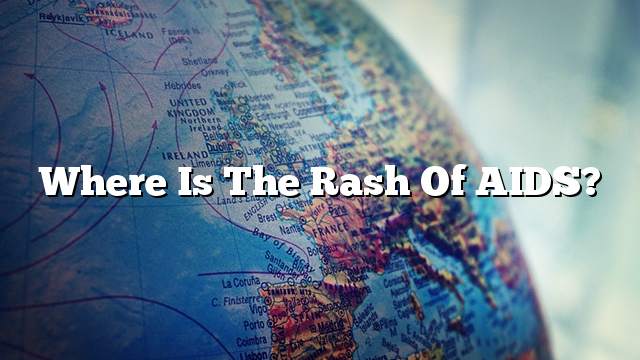AIDS
HIV / AIDS is one of the most serious diseases in history. It is one of the stages of HIV infection, which mainly affects T lymphocytes, and the patient’s condition is markedly worse. Diseases such as infections, diseases, and tumors. Among these cases are diseases and tumors affecting the skin. Some studies indicate that about 90% of AIDS patients suffer from symptoms and signs of skin rash and ulcers and others, and may be the emergence of the first indicators of the disease.
The rash of AIDS
In the case of AIDS, different skin disorders occur but may exist for other reasons. The rash of AIDS can be divided into three sections as follows:
- General rash : The most common symptoms of HIV infection, and has several types including:
- Dryness of the skin: This appears in the form of dry, scaly and itchy patches also, which are more prominent on the arms and legs.
- Atopic dermatitis: The term “atopic” is meant to be susceptible to hypersensitivity because this condition is chronic, causes irritation of the skin and shows a rash red itching.
- Akal al-Aqidi: It is a very annoying skin condition, usually similar to scabies, because the appearance of nodules on the skin itchy. They are usually infected with AIDS patients who suffer from a severe reduction in immunity.
- Eosinophilic hair follicle: A recurrent skin disorder of unknown causes, named because of the large number of immune cells in the infected tissues. This disease causes red, itchy patches to appear above hair follicles. It is noted that this disease affects the follicles located in the upper part of the patient’s body. Hair follicles often suffer from these patients in advanced stages of the disease.
- Inflammation of the skin : AIDS patients are more susceptible than others to infection of various types of infections, especially the skin, and many skin infections may affect AIDS patients, whether viral, bacterial, or fungal. The most common are as follows:
- Herpes zoster: This skin infection causes the same virus that causes chickenpox, and it leads to the emergence of painful bumps on different regions of the body, and the nature of this skin rash that affects the common areas of nutrition one nerve, and shows more on the parties in both sides and then spread Towards the trunk of the body, and may be more widespread in AIDS patients.
- Infectious Mellitus: A viral infection that affects both children and adults. This infection is characterized by the appearance of pink bumps or flesh on the skin of the affected person, and one of its advantages is that it is highly contagious and also requires repeated treatment sessions to ensure recovery and non-return. The skin rash associated with this infection appears on the upper extremities of the body in children. In adults, especially those with AIDS, rash occurs on the inner thigh, abdomen, or sexual areas due to sexual contact.
- Oral mucosa: This viral infection is characterized by the emergence of several white thick lesions on the tongue, and needs to be treated with anti-virus to get rid of it.
- Osteoporosis: It is also called oral candidiasis, a fungal infection that causes the appearance of a thick white layer on the tongue, and needs treatment with antifungal drugs as well as the use of mouthwash.
- Herpes simplex is a viral infection that usually occurs in AIDS patients in the early stages of the disease. It causes a red rash that has a regular border and is slightly higher than the skin. This rash contains vesicles that contain liquids that may explode to leave painful ulcers. : The first type causes the appearance of rash on the lips and around the mouth, and the second type shows his rash on the genital areas.
- Oncology : Acquired immunodeficiency syndrome (HIV) may be accompanied by multiple skin tumors, the most common of which is the so-called septic caporma, a type of cancer that affects the lining of the lymphatic and bloody vessels, causing the appearance of dark spots on the skin ranging in color between brown, purple and red. This type may affect the digestive system, lungs or liver, so it is characterized by shortness of breath and swelling in the skin. The appearance of these tumors in AIDS patients may indicate their transition from HIV infection to acquired immunodeficiency syndrome; This type of tumor responds to various treatment methods, whether radiological, chemical, or surgical, and may be less likely to occur if the patient receives antiviral treatment.
Treatment for the rash of AIDS
The treatment of the skin rash associated with AIDS depends on the treatment of the disease itself, but there are several ways that may help to alleviate this rash, and may even cure it sometimes, and these methods are as follows:
- Self-care : Include certain methods that prevent the appearance of rash or prevent the outbreak, wearing light and loose clothing, avoid bathing with hot water, as well as avoid exposure to direct sunlight, and not use chemical body preparations as well.
- Use of medicines : The use of drugs containing antihistamines, or those of steroid, as well as the use of antivirals if the patient was infected with herpes simplex or scabies. The use of liquid nitrogen or laser therapy may help to eliminate the infectious mellitus. For radiotherapy, chemotherapy or surgery.
